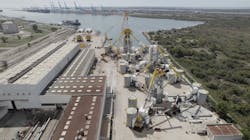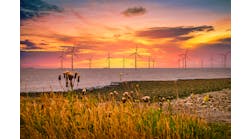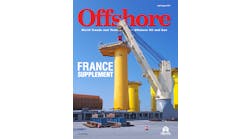Eiffage Metal scaling up capacity for future floating offshore wind parks
Editor's note: This article first appeared as part of a France special report in the March-April issue of Offshore magazine. Click here to view the full issue.
By Jeremy Beckman, Editor-Europe
France's government is working to speed up the permitting/consultation process for new offshore wind farms. Among those monitoring developments is engineering and construction group Eiffage Métal, supplier of the foundations for the country’s first fixed offshore wind farm, Saint-Nazaire, which started operating last summer in the Loire-Atlantique region. Currently, the company is supporting two pioneering floating offshore wind schemes in the Mediterranean Sea and one fixed wind development off western France. With a steady stream of French projects set to go forward later this decade, the company is considering ways of growing its local production capacity, including industrialization of floater fabrication for larger-scale floating offshore wind parks.
Provence Grand Large (PGL), a pilot 25-MW development led by EDF Renewables, in partnership with Enbridge Eolien France, is located 17 km from Port Saint Louis du Rhône in the Golfe de Fos off the central south coast. SBM Offshore is the EPCI contractor for the facilities which comprise three Siemens wind turbines, each mounted on triangular floating structures measuring 45 x 90 x 90 m (147 x 295 x 295 ft), and associated power cables that will connect to the local grid. The floaters are based on a TLP concept (Float4Wind) developed by SBM Offshore and IFP Energies Nouvelles and will be moored via a tension leg arrangement. The dynamic power cables will be capable of adapting to movements induced by the swell and local currents.
Eiffage Métal is a subcontractor to SBM, responsible for procuring raw materials, steel and certain components, and for assembly, welding and mechanical completion of the three floaters at the company’s yard nearby in Fos sur Mer. One of the main construction challenges at Fos has been the 45-m height of the floaters and the need for assembly at height, said Arnaud De Villepin, Director Energy & Industry for Eiffage Métal. “In front of the floaters there was a large amount of scaffolding at one point: it is not like working on platform topsides where access is relatively straightforward.” Around 150 people have been involved in the project at Fos: in addition, there have been local ground reinforcements at the yard and adaptations to the quay for the load-out operation, now expected to take place in May. At the quayside the three completed floaters will be loaded onto a semisubmersible barge which will be ballasted offshore until the structures are floating in the water. They will then be taken by tugs to another quay (‘Gloria’) 2 km from the yard where EDF will install the turbines, blades and towers in the central columns, followed by a further tow to the PGL offshore site, 20 km (12.4 mi) away for connection to the pre-laid cables.
Fos’ second floating offshore wind project is Ocean Winds’ Les Eoliennes Flottante du Golfe de Lion (EFGL), comprising three 10-MW wind turbines on three semisubmersible Windfloat units designed by Principle Power Inc. In this case, Eiffage Métal is the EPCI contractor for the floaters which will each measure 75 x 75 x 25 m (246 x 246 x 82 ft). However, assembly is behind schedule due to the impact of the war in Ukraine on global steel supplies. Earlier this year Fos received the bracings but was still waiting for the buoyancy elements to be shipped from Eastern Europe. The completed facilities will be installed in a marine reserve in the Golfe de Lion nature park: one of the three floaters will be fitted with a Biohut, an artificial fish habitat, to support biodiversity of species in the project area. The floaters will be positioned in a 2.9-sq km area, 16 km offshore in 68-70 m water depth.
“We are now considering concepts for industrialization of the floater fabrication process, including modularity,” De Villepin said. “One of our sites is better suited to production of the cylinders while another is more suited to bracings and assembly of floaters. This could involve a further adaptation to the quay and an extension at Fos, which is presently equipped to assemble six to seven floaters. However, future, connected floating offshore wind farms could require assembly of up to 20 floaters. We believe the market in France and Italy will start to take off from 2026 onwards.”
Late last year, Eiffage Métal secured a contract for Ocean Winds’ Îles d’Yeu et Noirmoutier fixed wind development spanning an 83-sq km area up to 16.5 km offshore western France, in water depths of 19-36 m. Subsidiary company Smulders is manufacturing the transition pieces in Hoboken, Belgium for the 62 x 8-MW Siemens Gamesa wind turbines. Deme, which will manage transportation and installation, previously worked with Eiffage Métal on Saint-Nazaire where the monopiles and foundations had to be drilled or driven due to the occasionally rocky seafloor. Noirmoutier’s seabed conditions are similar.
In March, France’s government was due to announce the winning bid for the Normandie/Centre Manche fixed wind development offshore Caen, northern France. Following the consultation process, construction will likely start in 2027. To support its pitch for involvement, Eiffage Métal may invest in new local construction sites in Brest or Cherbourg. Towards the end of 2023, an announcement is expected on South Brittany, France’s first large-scale floating wind development generating around 250 MW.
Aside from Noirmoutier, Smulders Hoboken is building almost 300 transition pieces (TPs) for the three phases of the Dogger Bank fixed wind farm in the UK southern North Sea, and by 2024, Hoboken should have reached the milestone of 3,000 TPS delivered for the fixed wind sector. “The European fixed offshore wind market remains very dynamic,” De Villepin said, “with the market increasing in the UK, Germany and France and elsewhere.” To match demand, further investments are under way at the group’s Wallsend complex in north-east England to adapt the site for TP manufacture.
In Norway, bid/permitting processes are advancing for the country’s first large-scale offshore wind park clusters. Eiffage Métal aims to participate as an EPCI contractor for the Utsira floating offshore wind development in the North Sea, where a minimum of 20 large floaters could be needed: it has held talks with Norwegian companies on adapting local yards for serial floater construction. Local ports too would need to be modified as the infrastructure is currently unsuitable for this type of work, De Villepin added.
Finally, the group is investigating supplying structures for the fixed offshore wind sector on the US east coast. It is currently producing secondary steel delivered to Port of Albany (New York State) for one project via a joint venture with Canadian company Marmen-Welcon, and is looking to form alliances with bigger contractors to bid for future developments that will be awarded on a state by state basis.




